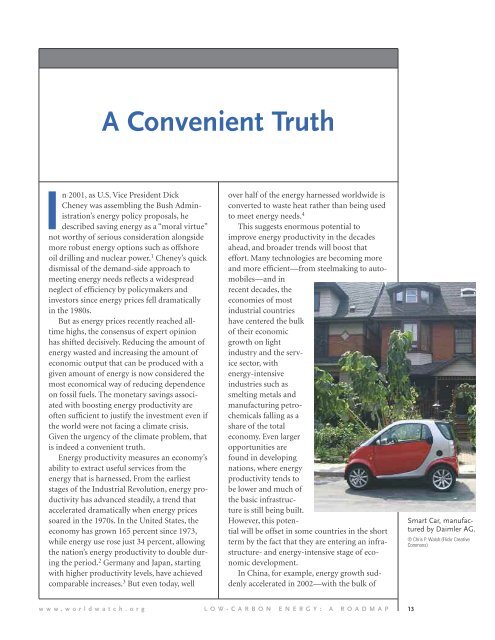Worldwatch Institute
Worldwatch Institute
Worldwatch Institute
Create successful ePaper yourself
Turn your PDF publications into a flip-book with our unique Google optimized e-Paper software.
A Convenient Truth<br />
In 2001, as U.S. Vice President Dick<br />
Cheney was assembling the Bush Administration’s<br />
energy policy proposals, he<br />
described saving energy as a “moral virtue”<br />
not worthy of serious consideration alongside<br />
more robust energy options such as offshore<br />
oil drilling and nuclear power. 1 Cheney’s quick<br />
dismissal of the demand-side approach to<br />
meeting energy needs reflects a widespread<br />
neglect of efficiency by policymakers and<br />
investors since energy prices fell dramatically<br />
in the 1980s.<br />
But as energy prices recently reached alltime<br />
highs, the consensus of expert opinion<br />
has shifted decisively. Reducing the amount of<br />
energy wasted and increasing the amount of<br />
economic output that can be produced with a<br />
given amount of energy is now considered the<br />
most economical way of reducing dependence<br />
on fossil fuels. The monetary savings associated<br />
with boosting energy productivity are<br />
often sufficient to justify the investment even if<br />
the world were not facing a climate crisis.<br />
Given the urgency of the climate problem, that<br />
is indeed a convenient truth.<br />
Energy productivity measures an economy’s<br />
ability to extract useful services from the<br />
energy that is harnessed. From the earliest<br />
stages of the Industrial Revolution, energy productivity<br />
has advanced steadily, a trend that<br />
accelerated dramatically when energy prices<br />
soared in the 1970s. In the United States, the<br />
economy has grown 165 percent since 1973,<br />
while energy use rose just 34 percent, allowing<br />
the nation’s energy productivity to double during<br />
the period. 2 Germany and Japan, starting<br />
with higher productivity levels, have achieved<br />
comparable increases. 3 But even today, well<br />
over half of the energy harnessed worldwide is<br />
converted to waste heat rather than being used<br />
to meet energy needs. 4<br />
This suggests enormous potential to<br />
improve energy productivity in the decades<br />
ahead, and broader trends will boost that<br />
effort. Many technologies are becoming more<br />
and more efficient—from steelmaking to automobiles—and<br />
in<br />
recent decades, the<br />
economies of most<br />
industrial countries<br />
have centered the bulk<br />
of their economic<br />
growth on light<br />
industry and the service<br />
sector, with<br />
energy-intensive<br />
industries such as<br />
smelting metals and<br />
manufacturing petrochemicals<br />
falling as a<br />
share of the total<br />
economy. Even larger<br />
opportunities are<br />
found in developing<br />
nations, where energy<br />
productivity tends to<br />
be lower and much of<br />
the basic infrastructure<br />
is still being built.<br />
However, this potential<br />
will be offset in some countries in the short<br />
term by the fact that they are entering an infrastructure-<br />
and energy-intensive stage of economic<br />
development.<br />
In China, for example, energy growth suddenly<br />
accelerated in 2002—with the bulk of<br />
Smart Car, manufactured<br />
by Daimler AG.<br />
© Chris P. Walsh (Flickr Creative<br />
Commons)<br />
w w w . w o r l d w a t c h . o r g L O W - C A R B O N E N E R G Y : A R O A D M A P 13









